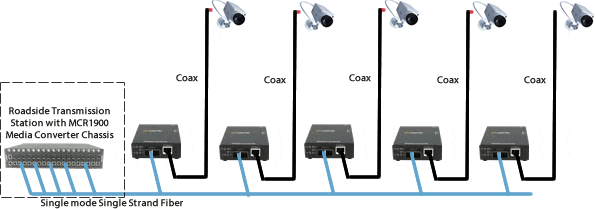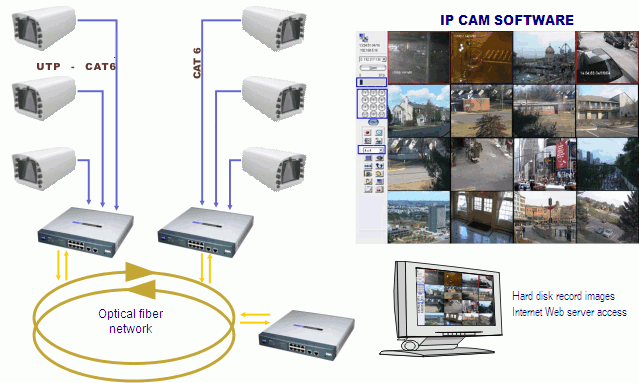Checking Out the Benefits of CCTV Cameras With Fiber Optic Outcome for Clearer Surveillance
The assimilation of fiber optic technology right into CCTV systems offers a compelling case for enhancing surveillance capacities throughout different atmospheres. Especially, these cameras provide exceptional photo quality and long-distance transmission, dramatically lowering the risk of signal interference. The implications of such developments expand beyond plain aesthetic appeals, recommending a transformative influence on safety operations and expense monitoring. As companies significantly prioritize efficient tracking services, recognizing the certain advantages of fiber optic result in CCTV systems ends up being important. What prospective applications and advancements might emerge from this modern technology?
Boosted Photo Clarity
In contemporary monitoring systems, boosted picture quality is paramount for effective surveillance and analysis. The development of CCTV video cameras with fiber optic result significantly boosts image resolution, supplying exceptional detail contrasted to traditional coaxial systems. This quality is important in identifying people, lorries, and various other crucial aspects in numerous environments, from urban landscapes to confined spaces.
Fiber optic modern technology sends information utilizing light signals, resulting in marginal signal deterioration over lengthy distances - cctv fibre optic cable. As a result, CCTV cameras outfitted with this modern technology keep high image top quality also at prolonged ranges, which is particularly useful for huge facilities or outdoor monitoring. The capability to record high-def images permits better recognition of faces, certificate plates, and various other vital information that may or else be lost in lower-resolution feeds
Additionally, improved picture clearness adds to enhanced logical capacities. Safety and security workers can make enlightened choices rapidly by leveraging high-quality visuals to analyze circumstances accurately. This improvement not just strengthens protection actions but also help in conformity with governing standards, where thorough paperwork is typically needed. Ultimately, the assimilation of fiber optic result in CCTV systems marks a significant progression in surveillance innovation, highlighting the value of clarity in effective surveillance.
Long-Distance Transmission
The response lies in the utilization of fiber optic technology, which has actually revolutionized the way video data is transmitted. Unlike conventional copper cable televisions, fiber optics transfer info making use of light signals, enabling for marginal loss of top quality over comprehensive ranges.

Additionally, the lightweight and adaptable nature of fiber optic cable televisions facilitate much easier installment and transmitting, making them perfect for complex surveillance configurations. Because of this, companies can successfully check substantial areas without jeopardizing on photo high quality or system performance. Inevitably, the combination of fiber optic modern technology right into CCTV systems enhances operational efficiency and offers a robust option for long-distance surveillance demands.
Reduced Signal Interference
Fiber optic technology not just allows long-distance transmission however likewise dramatically reduces signal interference, an usual challenge encountered in traditional surveillance systems. In conventional copper-based systems, electro-magnetic disturbance from nearby digital devices can misshape web link video clip signals, bring about degraded picture quality and unreliable security. This interference can result in blurred pictures, loss of detail, and gaps in protection, jeopardizing the effectiveness of security measures.
On the other hand, fiber optic cables transmit information as pulses of light, which are inherently immune to electro-magnetic interference. This particular permits for the upkeep of top quality video feeds also in environments with substantial digital sound, such as metropolitan areas or commercial sites. The use of fiber optics makes certain that CCTV systems supply clearer and much more dependable photos, essential for accurate monitoring and event response.
Additionally, the ability to run fiber optic cable televisions over fars away without signal deterioration means that security systems can be strategically positioned in ideal places without the concern of disturbance affecting efficiency. Consequently, taking on fiber optic innovation for CCTV cameras boosts the total robustness and integrity of monitoring procedures, inevitably adding to better security end results.
Cost-Effective Solutions
Economical remedies have actually ended up being increasingly essential for companies seeking to improve their monitoring abilities without sustaining extreme expenses. The assimilation of CCTV cameras with fiber optic result uses an engaging choice to traditional monitoring systems by decreasing installation and upkeep expenses. Fiber optic modern technology not just provides exceptional photo high quality however likewise permits longer wire runs without signal degradation, minimizing the requirement for multiple repeaters and extra framework.
Organizations can substantially decrease their overall expense by selecting fiber optic systems that require fewer resources for setup and upkeep. Furthermore, the sturdiness and resistance Continue to ecological variables of fiber optic materials add to lower substitute prices and minimized functional costs over time.
Moreover, the scalability of fiber optic surveillance systems this contact form makes it possible for companies to expand their monitoring capabilities as required without considerable economic investment. This versatility guarantees that businesses can respond effectively to progressing safety demands while keeping cost efficiency. Overall, adopting CCTV cameras with fiber optic result offers an economically sound technique for companies aiming to strengthen their monitoring efficiency while managing their budgets sensibly.
Versatile Applications
The adoption of CCTV cams with fiber optic result not just boosts expense efficiency but additionally opens up a variety of flexible applications throughout various industries. These advanced security systems are especially reliable in environments needing high-resolution imaging and durable information transmission, such as metropolitan infrastructure, transport hubs, and important centers.
In city areas, fiber optic CCTV allows real-time tracking of public spaces, boosting security while supplying beneficial information for website traffic monitoring and urban planning - cctv fibre optic cable. The transportation field benefits from boosted security in airports and train terminals, where high-def video feeds guarantee traveler security and functional efficiency
Furthermore, in commercial settings, these cams sustain the monitoring of harmful settings, permitting remote observation without jeopardizing employee safety. Health care centers additionally leverage fiber optic CCTV to protect delicate areas, securing individual privacy while keeping a visible security presence.

Verdict
In final thought, CCTV cameras with fiber optic outcome present various benefits that boost monitoring capabilities. The cost-effectiveness of fiber optics adds to reduce installation and maintenance expenses.